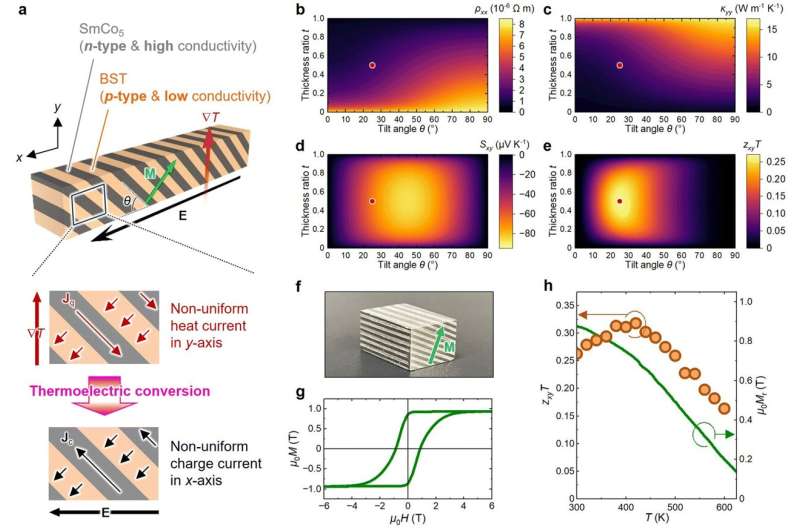In joint research with The University of Tokyo (UTokyo) and Nagoya University, the National Institute for Materials Science (NIMS) developed a new material “thermoelectric permanent magnet” exhibiting extremely high transverse thermoelectric conversion performance, and achieved transverse thermoelectric generation with a power density of 56.7 mW/cm2 around room temperature in a thermoelectric-permanent-magnet-based module.
When converted into a value per applied temperature gradient, this is not only the world’s highest power density among transverse thermoelectric modules, but a performance even comparable to commercial longitudinal thermoelectric modules. This achievement is expected to lead to thermal energy harvesting and management technologies that can be utilized everywhere magnets are used. This research result was published in Energy & Environmental Science on March 18, 2025.
Conventional thermoelectric modules adopt a longitudinal thermoelectric effect, called the Seebeck effect, in which a charge current is generated in the same direction as an applied heat current. In general, the figure of merit zT for the Seebeck effect can be high, but the Seebeck-effect-based devices face the problem of having a complex module structure in order to separate the circuits for heat and charge currents.
On the other hand, a transverse thermoelectric effect, in which a charge current is generated in the orthogonal direction to an applied heat current, has drawn attention in recent years, as the module structure can be simplified significantly. However, there has been the problem that zT of known transverse thermoelectric materials is extremely low compared to that of longitudinal thermoelectric materials.

The research group developed a “thermoelectric permanent magnet” with an artificially tilted multilayer structure consisting of an alternately stacked samarium-cobalt (SmCo5)-type magnet and bismuth-antimony-tellurium (Bi0.2Sb1.8Te3) compound that are sinter-bonded and cut in a tilted angle.
The group optimized the design of this tilted multilayer structure and minimized the electrical and thermal resistivities at the bonded interface, succeeding in obtaining two-orders of magnitude higher zT (= 0.2 at room temperature) than that previously reported by the anomalous Nernst effect in magnetic materials.
Moreover, in power generation experiments, a thermoelectric module comprising the thermoelectric permanent magnet developed by the group achieved a power density of 56.7 mW/cm2 at a temperature difference of 152℃. When converted into a value per applied temperature gradient, this is not only the world’s highest value among transverse thermoelectric modules, but a performance even comparable to commercial longitudinal modules.
Going forward, the research group aims to develop thermoelectric permanent magnet materials and thermoelectric generation / electronic cooling devices of even higher performance based on this research result. Having demonstrated thermoelectric generation performance comparable to commercial thermoelectric modules in a magnet, which is a material indispensable to human lives, this research is expected to lead to energy saving and energy harvesting technologies based on unprecedented concepts.
More information:
Fuyuki Ando et al, Multifunctional composite magnet realizing record-high transverse thermoelectric generation, Energy & Environmental Science (2025). DOI: 10.1039/D4EE04845H
Citation:
‘Thermoelectric permanent magnet’ achieves record power density for energy harvesting (2025, June 23)
retrieved 23 June 2025
from https://techxplore.com/news/2025-06-thermoelectric-permanent-magnet-power-density.html
This document is subject to copyright. Apart from any fair dealing for the purpose of private study or research, no
part may be reproduced without the written permission. The content is provided for information purposes only.

